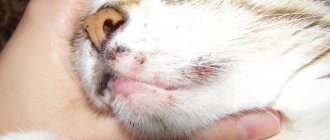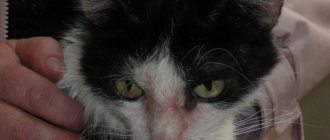Symptoms and treatment of throat diseases in cats
Medical otolaryngologists are still sometimes called "ear, nose and throat" doctors.
Following this tradition, a number of visitors to our forum ask to talk about the treatment of “throat diseases” of cats,” apparently implying tonsillitis, inflammation, swelling, spasm and stenosis of the larynx. In case of acute inflammation of the tonsils (tonsillitis), animals' body temperature rises, depression, lethargy, drooling, and difficulty swallowing appear, which causes a deterioration in appetite or refusal to feed. A cough appears - at first it is dry, then in most cases it is wet (productive). The voice changes (becomes hoarse, abrupt). In the upper part of the neck (in the submandibular spaces), enlarged lymph nodes are palpated; when pressed, the animal exhibits a painful reaction. The tonsils turn red, increase in size, and may partially block the lumen of the pharyngeal ring.
Depending on the nature and stage of the inflammatory process, the tonsils may be covered with clear or whitish mucus and pus; abscesses and erosions (small ulcers) may appear on them. Chronic tonsillitis is characterized by long-term manifestation (weeks and months) of the same symptoms, which are much less pronounced than in the acute course.
Inflammation of the larynx (laryngitis) is manifested by a cough (initially dry, and later it is accompanied by the discharge of sputum), changes in meowing (hoarseness, loss of voice, etc.), difficulty swallowing and taking water, a variable increase in body temperature and depression. The duration of the disease usually does not exceed 7-10 days. Under unfavorable conditions, it can develop into a subacute or chronic form. They are accompanied by the same, but less pronounced clinical signs as acute laryngitis, which persist for several weeks and even over a month. Chronic laryngitis may worsen.
Symptoms of the disease
Laryngitis in cats manifests itself in the same way as in humans. Colds and laryngitis have similar symptoms and treatment should be comprehensive. A pet owner should be wary if the following signs appear in a cat:
- loss of appetite;
- apathy, immobility;
- the appearance of wheezing in breathing;
- rapid breathing, shortness of breath;
- swelling and inflammation in the throat;
- slight increase in temperature;
- dehydration;
- dry cough, which later produces sputum;
- vomiting after coughing;
- The cat lies with its neck extended.
Types and signs of sore throat in animals
Diagnosing diseases in humans and animals are at very different levels, so the question of the relevance of the topic of sore throat in cats in general often arises. If you are wondering whether cats have tonsillitis, the answer is that it happens, however, this concept has a broader meaning than you are used to thinking.
According to the nature of the development of the disease, there are two types of sore throats:
Chronic or sluggish, can last for months.
Acute – dissipates quickly, most often accompanied by an increase in temperature, leukocyte levels and ESR in the blood. The acute form of tonsillitis is more difficult to tolerate, but with proper treatment, it quickly stops.
The cause of the disease can be several types of microorganisms; accordingly, tonsillitis can develop according to different “patterns”. Based on the nature of the inflammation, the following types of sore throat are distinguished in cats:
Catarrhal – accompanied by soreness, slight discomfort, and pain when swallowing. The pharynx is inflamed, the tonsils are slightly enlarged, the tongue is covered with a light coating, the temperature is stable and increased by 1–2°C, there is no fever, the pulse and breathing are rapid.
Croupous - accompanied by swelling and narrowing of the swallowing ring, the temperature is increased by 2–3°. In the acute form, there are symptoms of breathing problems, shortness of breath, refusal to eat and drink, a sore throat, pale mucous membranes. Attempts to eat are accompanied by coughing and the discharge of foamy discharge with food particles from the nose.
- Diphtheria is a rare form, accompanied by the appearance of a characteristic grayish-white coating, high fever, damage to all mucous membranes of the mouth and nose, and sometimes bleeding. The danger of diphtheritic sore throat is its rapid progression and a wide range of, sometimes irreversible, complications. The type is divided into two subtypes: Localized - the process occurs with general signs of malaise and is complicated by anemia, loss of strength, dizziness, and loss of appetite.
- Toxic - a rare, acute form of the disease, accompanied by fever, swelling of the respiratory tract, swollen lymph nodes, and increased salivation.
Ulcerative – on the visible surface of the pharynx, most often small ulcers open in the area of the tonsils. It seems to the animal that a foreign object is stuck in the throat; the cat opens its mouth, sticks out its tongue, and coughs. The disease can occur without an increase in base body temperature.
- Diphtheria is a rare form, accompanied by the appearance of a characteristic grayish-white coating, high fever, damage to all mucous membranes of the mouth and nose, and sometimes bleeding. The danger of diphtheritic sore throat is its rapid progression and a wide range of, sometimes irreversible, complications. The type is divided into two subtypes: Localized - the process occurs with general signs of malaise and is complicated by anemia, loss of strength, dizziness, and loss of appetite.
- Toxic - a rare, acute form of the disease, accompanied by fever, swelling of the respiratory tract, swollen lymph nodes, and increased salivation.
Ulcerative – on the visible surface of the pharynx, most often small ulcers open in the area of the tonsils. It seems to the animal that a foreign object is stuck in the throat; the cat opens its mouth, sticks out its tongue, and coughs. The disease can occur without an increase in base body temperature.
Signs
Fortunately, in cats, sore throat occurs in a mild catarrhal form. Typically, the body temperature remains normal or slightly rises, difficulty swallowing and coughing occur. The pet may try to get rid of the “foreign body” by frequently opening its mouth and moving its tongue.
Signs of a sore throat also include:
- Hoarse voice or lack thereof.
- Profuse salivation. You may foam at the mouth.
- Refusal of food.
- Formation of ulcers on the mucous membrane (a sign of calcivirosis).
- The appearance of discharge from the nose or eyes, sneezing.
- Enlargement of the cervical and submandibular lymph nodes.
When a bacterial infection occurs, the condition worsens - a high temperature appears, shortness of breath, the tonsils become greatly enlarged, and the oropharynx turns red. The plaque takes on a purulent or serous character.
Treatment
One of the first ways to help a cat with a sore throat is a special diet. Due to problems with swallowing and chewing, it is worth giving her only soft food, in the first days of illness - puree. Food should be warm and nutritious. Broths, vegetable and meat purees, as well as fermented milk products are suitable for these purposes. You can use baby food.
Provide your cat with peace. Try to move her sleeping place to a place that is not easily accessible, exclude active games and try to disturb the animal as little as possible.
Catarrhal form is treated by treating the throat with antiseptic solutions - furatsilin, a weak solution of potassium permanganate. You can treat the oral cavity with a spray or Lugol's solution.
If there is no purulent process (this is very important!!!), you can apply local warming compresses to the neck area. It is advisable to use immunomodulators for viral infections - Maksidin, Immunofan, as well as adaptogens - Gamavit
For viral infections, it is advisable to use immunomodulators - Maksidin, Immunofan, as well as adaptogens - Gamavit.
If tests show the presence of a bacterial infection, then antibiotic treatment must be prescribed. Amoxicillin and norulfazole are used for these purposes. The course should be at least 14 days with support from drugs for intestinal microflora (Lactobifadol, Bactoneotime).
Antipyretics (ketofen, Loxicom) and painkillers (aspirin) are prescribed symptomatically.
Cats should not be given paracetamol!!
Diagnostics
The first step is to determine whether there is a viral or bacterial infection. A routine blood test will help you do this. If there is an increased number of white blood cells, bacteria may be present.
It is also necessary to conduct a serological blood test for calcivirus or herpes infection. Bacterial analysis is carried out by inoculating material from scrapings from the tonsils.
We suggest you read: Why does a cat’s belly and hind legs go bald? What to do?
In cats, it is difficult to examine the pharyngeal cavity, so laryngoscopy is used for this - a special tube with a video beacon, which is inserted into the mouth.
It is also necessary to do a culture of the nasal discharge and mouth to detect chlamydial infection.
To exclude collapse of the trachea or the presence of a foreign body, an x-ray is performed to diagnose the neck area.
How to treat tumors in the throat?
The treatment regimen is determined by the veterinarian individually based on the etiology of the tumor; self-medication can harm the animal. If the throat is swollen due to cancer, surgery is performed. Excision of the tumor is carried out, capturing healthy tissue. A tracheostomy tube is often required to facilitate the breathing process. If metastases are detected, chemotherapy is prescribed. Cytostatic drugs are used that prevent tumor development by destroying malignant cells. However, this method has many side effects. Drug treatment includes immunomodulatory agents, vitamin-mineral complexes, antibiotics (for suppuration). Papillomas can be treated with liquid nitrogen or laser.
Treatment of sore throat in cats at home
Self-treatment comes down to comprehensive support of the body and increasing the level of immunity:
- Set up a comfortable resting place in a warm, well-ventilated area without drafts.
- The drinking bowl, feeder, litter tray and all pet accessories are transferred to the “hospital”.
- Avoid active games, pick up your pet more often, talk to the animal, and encourage it.
- Increase your caloric intake by 10–15%, avoiding fatty, hard, hard-to-digest foods.
- Provide the animal with warm liquid food.
If negative trends are observed on day 2, consult a veterinarian by phone. Based on your medical history, the doctor will tell you how to treat and possible options for maintaining the body, most often these are:
- Subcutaneous or intravenous glucose infusions.
- Warming alcohol compresses.
- For severe bacterial forms - penicillin, streptomycin, sulfadimezin, norsulfazole with parallel support of intestinal microflora.
Oral diseases: list and characteristics
Cats suffer most from gum disease that develops as a result of feeding poor quality food. Symptoms: hyperemia, swelling, ulcers, similar to signs of scurvy.
A strong odor from the mouth indicates tartar, an accumulation of food particles between the teeth. During the inflammatory process, there is a danger of tooth decay and the development of periodontitis.
Upon examination, reddened, swollen gums are visible, painful with areas of bleeding. If left untreated, the gums gradually recede from the tooth, forming pockets in which food accumulates. Putrefactive inflammation, caries, and periodontitis develop. The cat refuses to eat, becomes weaker, has unkempt fur, and saliva may flow from its mouth.
Infectious pathology, glossitis, indicates immunodeficiency conditions, feline leukemia, acute respiratory disease, viral immunodeficiency syndrome. Sometimes the inflammatory process appears when exposed to external factors, licking highly irritating substances. Symptoms: profuse salivation, sometimes foamy, anorexia, pain. Externally, the cat looks unkempt. After healing and disappearance of the inflammatory process, the surface of the tongue is smoothed, it becomes varnished, smooth without a hard brush. Erosion and ulcers often form.
Oral disease is manifested by severe salivation and inflammation of the mucous membrane. The cat refuses to eat, inspection of its mouth is difficult, it rubs its face with its paws and shakes its head.
Redness and swelling are noticeable on the mucous membrane, gums bleed, and there is a strong odor from the mouth. The cat seems to be “ruffling up”, looking unkempt and disheveled. In young cats, candidiasis (thrush) is diagnosed; the disease becomes more pronounced when treated with antibiotics, steroids, with low immunity, or after a serious illness. Symptoms of thrush: a whitish film on the tongue, gums; if left untreated, ulcers form on the mucous membrane.
This is a rare disease of the oral cavity, occurring as a secondary pathology against the background of a viral infection, diseases of the mouth and pharynx. With pharyngitis, the temperature rises, pain, cough, and nausea appear. No appetite.
Inflammation of the tonsils is rarely diagnosed in cats. Hyperthermia (above 39.4C), lethargy, and anorexia are observed. The underlying cause of the disease is a bacterial infection.
In case of recurrent tonsillitis, removal of the tonsils is indicated, since greatly enlarged tonsils interfere with the normal passage of air into the lungs, cause attacks of suffocation, and interfere with food intake.
Neoplasms of the salivary glands.
Cysts and tumors form under the influence of external factors. As a rule, the salivary gland is damaged in cat fights, when a foreign object enters. The accumulating fluid ruptures the duct and a cyst is formed - a mucocele.
The submandibular gland is most often affected; when palpated under the tongue, a smooth, large cyst can be detected. Neoplasms disturb the animal, making it difficult to breathe and swallow. More often, complete removal of the damaged salivary gland is required; punctures and rinses do not give the desired effect.
In older cats, tumors are (usually) malignant and appear as hard, slow-growing lumps on the side of the face or neck.
Needles, bones, fragments, chips, thorns, threads get into the oral cavity. The specific structure of the tongue with papillae curved inwards does not allow a foreign object to fall out. It is easy for a breeder to understand that something has got into the cat’s mouth; she shakes her head, meows, and tries to reach with her paws what is bothering her. Severe drooling, restlessness, refusal to eat.
Particularly dangerous are the bones from fish, which dig into the soft tissues of the mouth and pharynx and “sit” there without causing signs of concern. After a few days, the bone rots, a strong odor from the mouth appears, intoxication, weakness, and apathy develop. If the outcome is successful, the bone comes out with a ruptured abscess and pus.
It is found in the middle of the upper lip, sometimes on the lower or oral mucosa. It looks like a yellow or reddish shiny spot that turns into a weeping erosion without pain or itching. Diffuse growth: the ulcerated surface increases, teeth and gums are exposed. Jacobs ulcer has a tendency to develop into cancer or fibrosarcoma. The cause of the pathology is not clear; a connection is suggested with dental infections and the feline leukemia virus.
Types and symptoms: what are the pathologies?
Lymphosarcoma
The tumor is a malignant tumor and affects the lymph nodes. Due to the influence of unfavorable factors, a pathological accumulation of lymphocytes occurs, which become the cause of oncology. May spread to bone marrow. The disease develops against the background of long-term chronic illnesses, decreased immunity, and the animal staying in areas with increased radioactive radiation. Symptoms:
- difficulty breathing;
- enlarged lymph nodes;
- exhaustion due to intoxication and deterioration of swallowing function;
- stool instability;
- depressed state.
Squamous cell carcinoma of the throat
The presence of purulent discharge provokes an unpleasant odor.
Develops in the oral cavity from flat cells of the mucosal epithelium. The neoplasm forms on the tongue or palate and can invade the tonsils, metastasizing to the structures of the throat. The cause is chronic inflammation of the larynx, untreated stomatitis, as well as licking of toxic components of antiparasitic agents from the fur. Signs:
- the appearance of erosions and ulcers in the throat;
- suppuration;
- strong bad breath;
- profuse drooling;
- nasal discharge if the cancer has spread to the upper jaw or nasopharynx;
- loss of appetite;
- stretching the neck forward when the animal is lying down;
- difficulty swallowing.
Poorly differentiated cancer
Most often it forms in the nasopharynx, from where it can spread to other tissues of the throat. The tumor can give extensive metastases to the brain, liver, lungs and has a rapid and aggressive course. Pathology occurs due to throat injuries, chronic respiratory infections, and weak immunity. Manifestation:
- lethargy, fatigue;
- noisy wheezing;
- dyspnea;
- problems with eating and swallowing;
- unkempt appearance;
- the appearance of lumps that can be felt through the skin;
- sudden weight loss.
Papillomatosis of the throat
Cats have their own papilloma virus, which is not transmitted to humans. And also, an animal cannot become infected with papillomatosis from people.
There is a risk of the tumor degenerating into a malignant one.
Papillomas most often occur on the body and face of the animal, but can develop in the mouth and throat. Infection occurs through contact with a carrier of the virus, through damaged mucous membranes, wounds, and scratches. The growth has a smooth surface and a stalk. The virus is activated due to reduced immunity, chronic diseases, frequent stress, and age-related changes. The danger of papillomas is that they can degenerate into laryngeal cancer. Signs:
- loss of appetite;
- apathy;
- the animal swallows frequently;
- difficulty breathing when tumors grow.
Polypous formations
Polyps in a cat's throat often appear due to nasopharyngeal formations. They are formed from mucosal tissues. Pathology occurs due to congenital anomalies in the development of the ENT organs or if the cat often has a sore throat due to respiratory tract infections. The main symptom is difficulty breathing and swallowing, as well as:
- cough, sneezing;
- change in voice timbre;
- nasal discharge;
- weight loss.
The cat has a sore throat
Possible complications and consequences
Despite the conservative and surgical treatment, one should not exclude possible complications and consequences, including:
- loss of voice function;
- food entering the larynx and other organs of the respiratory tract;
- cough, shortness of breath, whistling when breathing, residual noise;
- gagging after eating;
- seam divergence;
- hematomas;
- aspiration pneumonia.
Complications after surgical treatment are observed in 30-40% of animals. For example, after resection of the larynx, pneumonia is diagnosed in 35-45% of patients. It should not be ruled out that the death of the pet may occur due to serious complications. The final result is influenced by the age, general condition of the pet, conditions of care and maintenance, chronic, congenital pathologies of the nervous system.
Please note that after the operation, if the clinic provides a medical examination service, leave the cat for a day under the supervision of veterinarians.
Prevention measures
It is much easier to prevent any disease or disease than to treat it, especially if the disease has become chronic.
Prevention in cats involves:
- Systematic proper care of your pet.
- Creation of optimal conditions of detention.
- Compliance with immunization and deworming schedules.
- Balanced nutritious diet.
- Caring attitude towards the cat.
- Completing preventive examinations at the clinic twice a year, especially for older cats, animals with congenital defects, and nervous pathologies.
Avoid hypothermia and overheating. Do not keep the animal in drafts. If your cat is walking down the street, after the walk, examine your pet for injuries, wounds, or parasites.
List of drugs and antibiotics
The choice of a specific drug, the prescription of its dosage, the frequency of use and the duration of the course of administration should be done only by a veterinary specialist. List of medications used to treat tracheitis in cats:
- antibiotics - Baytril, Tsiprovet, Ceftriaxone, Amoxicillin, Marfloxin;
- antiviral drugs – Neotime, Neoferon, Camedon, Anandin, Fosprenil, Dostim;
- means for relieving cough and removing phlegm - Terpinhydrate, Bronchipret, Butamira, Mucaltin.
- antihistamines - Tenset, Astemizole, Terfenadine, Soventol, Fenistil, Kestin, Fexofenadine and Cetirizine;
- immunostimulants - Mastim, Gamavit, Nucleopeptide, Fosprenil, Gamapren, Gala-vet, Neoferon, Kinoron.
Clinical symptoms and diagnosis
With calcivirosis, problems occur with swallowing due to ulcers on the tongue.
Dysphagia can be suspected based on the following pathological symptoms:
- profuse salivation with or without blood;
- cough and regurgitation after feeding;
- gagging;
- chewing food on one side of the jaw if dental disease has occurred on the other;
- halitosis - stench from the mouth;
- crusts around the nose;
- picky eating;
- exhaustion;
- curvature of the neck;
- head shaking;
- plaintive meowing for no apparent reason.
The initial diagnosis is made by the cat owner if he notices at least 2 or 3 of the listed pathological signs. The cause of the disease is determined based on a clinical examination of the medical history and additional studies prescribed by a veterinarian.
How to treat a sore throat in cats
Information article on the topic: “A cat has a sore throat, how to treat it” with a full explanation and understandable language. The article fully covers the topic, but if you have any questions, please ask them.
What to do if your cat has a sore throat?
One of the most common throat diseases in cats is sore throat or acute tonsillitis. Often, simple inflammation can develop into viral stomatitis. Therefore, it is necessary to closely monitor the animal in order to notice at the first signs when the cat has a sore throat, and to avoid complications with the help of timely treatment.
general information
During a sore throat, the swallowing ring becomes infected, causing swelling of the throat and tonsils.
The disease occurs due to infection of the cat with microorganisms such as staphylococci and streptococci and must be treated immediately.
Even if a cat has never had a sore throat, this does not mean that this illness may not affect it. You need to carefully monitor the animal, and not miss the moment when your pet has a sore throat.
Staphylococcus in cats is a type of microorganism that causes diseases that are difficult to treat and have possible serious complications. This name unites a whole family of pathogenic microbes.
Streptococcus in cats is a type of microorganism that is caused by bacteria from the genus Streptococcus. It is considered the causative agent of severe pathological processes that require rapid response and relief.
Sore throat in cats is always a severe inflammation of the throat, larynx and tonsils, which can be identified by certain symptoms. It does not happen without pain, nasal discharge, swelling of the mucous membranes, and in especially severe cases it becomes difficult for the animal to swallow. This ailment, which is not dangerous at first glance, can become a serious problem for a pet.
Types and signs
According to the nature of the development of the disease, two forms are distinguished:
- chronic – the animal’s throat hurts for several months.
- acute - develops instantly. The animal's temperature rises, it hurts the cat to swallow, and the number of leukocytes and ESR in the blood increases. It is more difficult to tolerate than chronic, but goes away quickly with well-chosen treatment.
According to the nature of the course of inflammation, depending on the microorganism that caused the disease, several types are distinguished:
- catarrhal - determined by tingling in the throat and pain when swallowing. In cats, the pharynx becomes inflamed, the tonsils are slightly enlarged, a whitish coating is noticeable on the tongue, the temperature is slightly higher than normal, and in rare cases the voice disappears.
- croupous - determined by swelling and compression of the swallowing ring, the temperature is 2-3 degrees above normal. When the disease is severe, breathing becomes impaired, shortness of breath appears, the cat refuses food and water, the throat hurts, and the mucous membrane becomes pale. A cough appears when trying to eat food, and unpleasant discharge comes out of the nose; the cat cannot meow, but can only wheeze.
- diphtheria - determined by a gray-white coating, a temperature much higher than normal, infection of the mucous membranes of the mouth and nose, and even blood. Happens rarely.
- ulcerative - determined by small ulcers on the pharyngeal mucosa, especially in the tonsil area. The temperature may be normal.
Home treatment is allowed only if there are no serious complications and if the cat does not refuse food and water. In case of severe manifestations of the disease, you should immediately seek help from a doctor.
When treating a throat at home, you need to intensively support the animal’s body and increase immunity.
Recommended:
- place the cat in a warm room without drafts
- surround the animal with affection and care
- increase caloric intake and avoid hard-to-digest foods
- Give your pet only warm liquid food
If on the second day there are no changes for the better, and the animal still has a sore throat, you should urgently contact a specialist and show him the cat.
Based on the results of an examination of the throat, the veterinarian can prescribe the best ways to maintain the cat’s body:
- subcutaneous or intravenous glucose infusion
- alcohol compresses for warming
- immunostimulants
- in particularly difficult cases - antibiotic therapy and parallel strengthening of the intestinal microflora
It is strictly forbidden to prescribe antibiotics yourself to treat a sore throat in a cat. Recommendations should only be made by a specialist
How is treatment and prevention carried out?
When something starts to interfere with your pet’s mouth and throat, it’s worth taking the cat to the veterinarian. This measure will allow you to prevent dangerous diseases or begin their treatment in time. In case of a pathological process in the pharynx, treatment with antiseptics and herbal decoctions with an astringent effect is required. During treatment, they adhere to a special diet and give the cat liquid food. Antibiotics are also prescribed for diseases that are complicated by a purulent process. Sore throat in cats and other diseases of similar localization are observed less frequently when preventive measures are carried out. For this purpose, monitor the animal’s diet and brush its teeth. It is not recommended to give your cat bones or other hard objects that could cause injury.
Surgical methods of treatment
Treatment methods are prescribed by a veterinarian after diagnosis. The specialist takes into account the cat’s age, general condition, stage, and nature of the pathology. To alleviate the course of the disease, symptomatic therapy is used. Animals are prescribed diuretics, corticosteroids, sedatives, anti-inflammatory, decongestant medications, and homeopathic medications.
Additionally, treatment is carried out for concomitant diseases that were identified during the examination.
Oxygen therapy will help eliminate the symptoms of hypoxia. In emergency cases, temporary tracheotomy and tracheal intubation are performed to normalize respiratory function.
At the same time, the main method of treating PG in animals is surgery. Indicated for cats with pronounced, severe clinical symptoms and manifestations. The veterinarian can use both intralaryngeal and extralaryngeal methods of surgical treatment.
Surgical methods of treatment:
- Partial resection of the larynx.
- Excision of vocal cords, ventricles of the larynx.
- Laterization of the arytenoid and cricoid cartilage.
- Laterization of the thyroid and arytenoid cartilage.
- Installation of implants to support the shape of the larynx.
The most effective technique is lateralization of the arytenoid cartilage.
Diagnostic methods
If you notice problems with your pet's breathing, immediately take him to the veterinary clinic for an examination.
Diagnostic methods:
- Collection of anamnesis data.
- Full visual inspection.
- Serological studies (hormone analysis).
- ECHO.
- X-ray, chest X-ray.
- CT, MRI of the brain.
- Laryngoscopy.
- Auscultation.
- Electromyography.
If necessary, a number of additional tests and studies are carried out, differential diagnosis, since the symptoms of laryngeal paralysis are similar to many viral, bacterial, respiratory diseases, and the presence of a foreign body in the larynx.
What is laryngeal paralysis in cats and its causes?
Laryngeal paralysis in cats (LP) is a neurological disease that occurs due to impaired inspiratory abduction of the arytenoid cartilage due to dysfunction of the laryngeal muscles. Air in the required volume does not reach the lungs. Respiratory (breathing) function and gas exchange are disrupted, and oxygen starvation develops.
Causes of laryngeal paralysis in cats:
- Severe injuries to the spinal column, accompanied by spinal cord contusion. Most often they occur due to falls from heights and car accidents.
- Inflammation of the spinal cord that develops against the background of a viral, bacterial, or parasitic infection.
- Injuries, damage to the neck, sternum.
- Poisoning with potent poisons, toxins, chemicals, organophosphorus compounds, salts of heavy metals, chronic, acute intoxication.
- Age-related changes in the body.
- Neuromuscular diseases.
- Chronic nervous diseases, pathologies (peripheral neuropathy, vagus nerve dysfunction).
- Neoplasms benign, malignant.
- Birth defects.
- Myasthenia.
- Genetic, breed predisposition.
In cats, like other domestic animals, paralysis develops due to the collapse of the trachea. In this case, the pet requires urgent veterinary care. The count can go on for hours.
Neurological pathology is aggravated by endocrine problems (endocrinopathy), cardiovascular pathologies, diabetes, obesity, and other systemic disorders and illnesses.
With regards to breed and genetic predisposition, PG is diagnosed in representatives of Persian, Siamese breeds and their crossbreeds. Choking, neck injuries, unsuccessful operations in the neck and sternum can also lead to the development of this pathology in cats.
Causes of the disease
How can an animal get laryngitis? The disease is provoked by the following factors:
- drinking cold water or frozen food;
- prolonged exposure to cold, draft;
- dampness;
- presence of caustic substances or smoke in the air;
- allergy;
- past infectious diseases.
If laryngitis appears as a result of hypothermia, the animal’s condition can be improved by providing it with warmth and heated food. When the disease develops as a complication of bronchitis, pneumonia or a viral infection, treatment by a veterinarian will be required.
In the absence of medical care, the animal may die from suffocation, since the mucous membrane of the larynx narrows greatly.
What to do if your cat has a sore throat?
In the case of the lips, this can cause the formation of ulcers, which must be distinguished from eosinophilic ones (using a biopsy).
Treatment options for squamous cell carcinoma in cats include local radiation therapy (brachytherapy), surgical excision, and cryosurgery (freezing affected tissue to cryogenic temperatures). The success of treatment depends on the degree of development of carcinoma. With timely diagnosis, it is often possible to completely remove cancerous tumors.
A cleft lip is a congenital defect in which a cat's upper lip is not fully formed. A cleft lip is noticeable in kittens immediately after birth. The defect may extend to the nose and be accompanied by a cleft palate (a defect in the upper part of the mouth). The severity of the disease can vary and to a moderate extent may not interfere with the cat's normal life.
One of the most common throat diseases in cats is sore throat or acute tonsillitis. Often, simple inflammation can develop into viral stomatitis. Therefore, it is necessary to closely monitor the animal in order to notice at the first signs when the cat has a sore throat, and to avoid complications with the help of timely treatment.
- general information
- Types and signs
- Treatment
general information
During a sore throat, the swallowing ring becomes infected, causing swelling of the throat and tonsils.
The disease occurs due to infection of the cat with microorganisms such as staphylococci and streptococci and must be treated immediately.
Even if a cat has never had a sore throat, this does not mean that this illness may not affect it. You need to carefully monitor the animal, and not miss the moment when your pet has a sore throat.
Feeding and caring for a sick cat
After treatment, cat owners must strictly observe and follow all the veterinarian’s recommendations. Balanced feeding and care of a sick cat is the key to a quick recovery for your pet.
Important! After surgery, the animal may be prescribed medications, vitamins, and dietary adjustments may be made, for example, to reduce weight.
For the first week after surgery, do not leave your cat unattended. Systematically monitor the animal’s condition and contact a veterinarian at the slightest deviation.
Protect your cat from stress, hypothermia, overheating, and other unfavorable factors that weaken the body.
If you have problems with eating solid food, use wet, canned food, pates, or give natural products in crushed pulpy form for feeding. Do not force feed or water the animal.
Oral diseases in cats.
Acute stomatitis.
Acute stomatitis is a rapidly developing inflammation of the oral mucosa. Often accompanied by inflammation of the tongue (glossitis) and/or inflammation of the throat (pharyngitis).
The most common causes of stomatitis are:
- Calicivirus or herpesvirus infection
(cat flu). Both feline calicivirus (FCV) and feline herpes virus (FHV) can cause inflammation in the mouth, usually accompanied by other upper respiratory symptoms such as sneezing and nasal and eye discharge. Calicivirus infection usually causes sores in the mouth, often on the edges of the tongue, but sometimes in other places, including the cat's nose. Herpesvirus often causes more severe consequences than calicivirus, and signs of infection in some cats include quite noticeable pharyngitis, but ulcers are less common. - Irritations
. Many common household substances - cleaning products, paint, bleaches, etc. may be irritating to cats. Out of curiosity, the cat may sometimes lick or swallow them, causing irritation in the mouth and throat. In some cases, the consequences can be very severe. The best protection is to prevent your cat from coming into contact with such substances, so they should be stored in a safe place, out of reach of the cat. - Dental diseases
, gingivitis.
Dental disease, periodontal disease (the tissue around the tooth), and gingivitis are also common in cats, as in other animals.
Oral malignancies (cancer).
Several types of tumors are possible in cats. To make an accurate diagnosis, a biopsy of tumor tissue is necessary. Malignant tumors (cancer) are more common than benign tumors, with squamous cell carcinoma (a cancerous growth of epithelial cells in the lining of the mouth) appearing to be the most common type of tumor. Most often, such tumors affect the tongue, especially its lower side, but can develop anywhere in the oral cavity. Typically, the disease occurs in older cats.
Oral tumors rarely spread to other parts of the cat's body, but often recur after removal. An exception to the rule is squamous cell carcinoma of the tonsils, which often spreads to other tissues. In all cases, the effect of treating cancerous tumors is temporary, and you need to be prepared for the fact that sooner or later you will have to resort to euthanasia in order to avoid unnecessary suffering.
Diseases of the salivary gland.
Diseases of the salivary gland are rare in cats. In very rare cases, blocked salivary ducts can cause swelling under the tongue or in the neck. This condition can be successfully treated surgically. It is extremely rare for cats to develop tumors of the salivary glands.
Foreign bodies.
It is not uncommon for foreign bodies, such as wood chips or bones, to become wedged into the palate or between the cat's teeth. This causes extremely unpleasant, often painful sensations in the cat. The cat rubs its mouth with its paws, trying to get rid of a stuck foreign object. To remove a foreign body, local and sometimes even short-term general anesthesia is used.
Cleft palate.
Cleft palate is a developmental disorder in kittens, which (although not always) is of a genetic nature. Sometimes a cleft palate can be observed simultaneously with a cleft lip. The disease appears immediately after birth, as the kitten has difficulty sucking milk and it gets into its nose. Sneezing, breathing noises, and pain are common. Sick kittens grow poorly, and pneumonia can develop due to milk entering the respiratory tract. Treatment is usually useless; it is better to immediately resort to euthanasia.
Causes
The most common causes of sore throat in cats are calcivirus, herpes, chlamydia, mycoplasma and rhinovirus infections.
However, viruses rarely affect a healthy animal or the absence of provoking factors. These include:
- Eating cold, poorly defrosted food or water.
- Injuries, especially from chicken or fish bones.
- Decreased immunity.
- Diseases of the teeth or gums.
- Inhalation of toxic fumes or gases.
Sometimes the main viral sore throat can be complicated by the addition of a secondary infection.
The causes of swallowing disorders are usually divided into several large groups:
- mechanical;
- traumatic;
- caused by infectious brain damage;
- caused by damage to the cranial nerves.
Oral distress can be caused by trauma to the jaw, dental disease, or abscesses in the mouth or throat. In this case, swallowing is impaired due to acute pain. If an animal is injured, there may be visible violations of the integrity of the bones, blood in the saliva, bad breath, and an abscess leads to deformation of the jaw at the site of formation.
Lymphadenopathy (inflammation of the lymph nodes of a bacterial nature or the formation of tumors) in the submandibular region leads to visible deformation of the neck, difficulty swallowing, the animal may be apathetic, its temperature rises and all other signs of general intoxication appear.
Congenital anomalies (cleft palate or short frenulum of the tongue) make it difficult for the animal to eat without losing its appetite. With a cleft palate, some of the food gets into the nose, the animal may sneeze and cough, and choke.
Swelling of the pharynx due to allergies or inflammation leads to a narrowing of the pharyngeal ring and difficulty in moving food. Allergies can cause laryngospasm and suffocation.
Ordinary myositis, inflammation of the masticatory muscles, can lead to impaired swallowing. Due to pain and dysfunction, it is difficult for the animal to chew food. Dysphagia can be caused by infectious polymyositis caused by toxoplasmosis.
Damage to the nerves (trigeminal, glossopharyngeal, cranial) leads to the inability of the animal to move food using the tongue; it tries to solve the problem using adaptive behavior.
Swallowing disorders can develop after a stroke, traumatic brain injury, and some other pathologies affecting the animal’s brain. In this case, the cat experiences not only a loss of the ability to swallow, but also other disorders, paralysis, and loss of consciousness.
Autoimmune diseases, polyneuropathy, muscular dystrophy that affects the masticatory apparatus lead to the fact that the animal cannot perform the usual chewing and swallowing movements.
Some infectious diseases lead to muscle damage or disruption of the transmission of nerve impulses to the masticatory muscles, for example, botulism, rabies, tick-borne encephalitis. All these diseases are accompanied by their characteristic symptoms.
A foreign body is one of the most common causes of swallowing disorders in animals. Particularly often affected are cats whose owners feed them fish or allow them to gnaw on the tubular bones of birds. In this case, the bone can get stuck in the soft tissues of the palate or pharynx, the animal coughs, vomits, and tries to scratch with its paws near the cheeks and mouth.
What to do if your cat has a sore throat?
In the case of the lips, this can cause the formation of ulcers, which must be distinguished from eosinophilic ones (using a biopsy).
Treatment options for squamous cell carcinoma in cats include local radiation therapy (brachytherapy), surgical excision, and cryosurgery (freezing affected tissue to cryogenic temperatures). The success of treatment depends on the degree of development of carcinoma. With timely diagnosis, it is often possible to completely remove cancerous tumors.
A cleft lip is a congenital defect in which a cat's upper lip is not fully formed. A cleft lip is noticeable in kittens immediately after birth. The defect may extend to the nose and be accompanied by a cleft palate (a defect in the upper part of the mouth). The severity of the disease can vary and to a moderate extent may not interfere with the cat's normal life.
One of the most common throat diseases in cats is sore throat or acute tonsillitis. Often, simple inflammation can develop into viral stomatitis. Therefore, it is necessary to closely monitor the animal in order to notice at the first signs when the cat has a sore throat, and to avoid complications with the help of timely treatment.
- general information
- Types and signs
- Treatment
Types of dysphagia
Fights cause dysphagia.
Swallowing disorders are divided into anatomical and functional. Morphological dysphagia can be congenital or acquired due to injury. Functional ones develop as a result of inflammatory or neurological diseases.
Based on localization, the following types of disorders are distinguished:
- Oral: The animal is unable to grasp food or form a bolus using the tongue and mouth. The cat chews for a long time, shaking its head so that the food falls into the throat.
- Pharyngeal: the relationship with the swallowing and gag reflexes is disrupted. Some of the food is regurgitated and ends up in the nasal passages. If the larynx becomes blocked, the pet dies from suffocation.
- Esophageal or esophageal. Food gets stuck in the esophagus and does not enter the stomach. A cough occurs, causing vomiting. The animal is starving and quickly loses weight.











